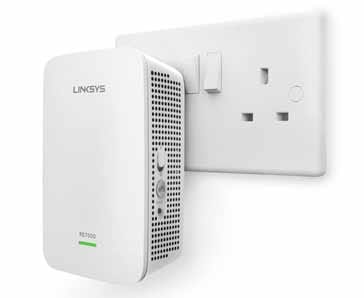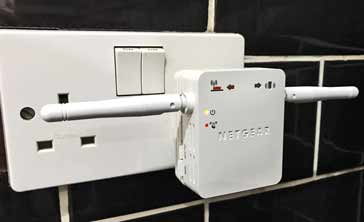Wi-Fi Boosters, Range Extenders & Repeaters
If you are having trouble with Wi-Fi coverage, a range extender, booster or repeater could be the solution.
WiFi IEEE 802.11 Includes:
Wi-Fi IEEE 802.11 introduction
Standards
Wi-Fi Alliance generations
Security
How to stay safe on public Wi-Fi
Wi-Fi Bands
Router location & coverage
How to get best Wi-Fi performance
How to buy the best Wi-Fi router
Wi-Fi boosters, range extenders & repeaters
Wi-Fi mesh network
Wi-Fi wired & powerline extender
Buy Wi-Fi equipment
Key Wi-Fi standards / variants:
802.11n
802.11ac
802.11ax Wi-Fi 6
802.11be Wi-Fi 7
Details of other standards variants
Although Wi-Fi routers are now more effective than ever before, there can still be issues with dead-spots and poor coverage in the home or office.
One of the solutions to this issue is to use what can be termed, range extenders, boosters or repeaters.
These extenders, boosters and repeaters perform basically the same function, although there are some different types, but to add to the confusion, often the terms are used interchangeably, and one person may use one term to talk about one type of item, whereas others will use the same term to talk about another, so we will try to explain what these items are, how they work, and their advantages and disadvantages.

Normally these extenders or repeaters are very easy to install and set up, and they can enable issues of poor coverage to be resolved very easily.
Wi-Fi boosters or range extenders
The term wireless booster indicates that the equipment just this - it boosts the Wi-Fi signal and extends the range of the router. Often these Wi-Fi boosters are plugged directly into the main router, typically via the Ethernet port and they transit a stronger signal.
Usually boosters refer to an upgrade at the Wi-Fi router itself making the Wi-Fi signal stronger. It can be an amplifier for the transmitted signal, or in some cases it may be a better antenna.
However be aware that a booster is not a total solution. To have good coverage, it is necessary to be able to communicate in both directions. The client, i.e. the item connected to the Wi-Fi router needs to be able to send data back, and the booster, if it is an amplifier will not affect this. So a booster on its own is unlikely to make much of a difference in many instances. Better antennas, though will make a difference as these will normally work in both directions.
Wi-Fi repeaters work
Wi-Fi repeaters are another item used for extending the range and coverage. Often they are also called range extenders, so make sure you know what you are buying.
As the name implies, a Wi-Fi repeater is a device that repeats the wireless signal from the main router to expand its coverage. It receives the Wi-Fi signal from the main router and then re-broadcasts it. In this way it is able to extend the range of the main router signal, allowing coverage of areas that are not covered by the main Wi-Fi router.
The repeater has the same SSID (Service Set IDentifier) as the main access point, normally making connection easy.
The Wi-Fi repeater receives a frame from the main router, and then re-broadcasts it. This naturally takes twice as long (if not more) to transmit the frame to the final receiver. As such the performance of the wireless network will be slowed to at best half the rate of the original network.
Repeaters are a very good solution when coverage of a large residence is required, but care needs to be taken if large amounts data, for example by video streaming, are to be used as the performance will be less than normal. With the speeds available today, this may be more than adequate, but it is best to be aware of the issue.
Some more advanced repeaters make use of dual band technology to enable the best operation to be achieved.
Powerline / Homeplug extenders
One of the options available is to use what is termed a Powerline extender. These typically use a standard known as Homeplug which transmits the data signal over the mains power lines within the home.
The powerline Wi-Fi extender has the advantage that it does not degrade the performance of the Wi-Fi network.
Setting up a repeater
The repeater style Wi-Fi range extenders are normally easy to set up. The actual set-up of the repeater so it logs into the main router, etc. will be determined by the actual repeater itself. Normally developers and manufacturers of these products have created secure but easy methods of enabling the new repeater to log onto the Wi-Fi network.
The placement of the repeater is key to the performance. It must be placed in a position where it receives a good signal from the main Wi-Fi router and also where it can provide good coverage of the dead-spot. Remember Wi-Fi signals do not like passing through metal objects like kitchen white goods, as well as thick walls, etc.
Typically placing the Wi-Fi repeater where it has a straight line path to the main router, and then a straight line path to the Wi-Fi dead-spot. Often this means the repeater will be about half way between the router and the new coverage area.
Many Wi-Fi repeaters come with a smartphone app that can be downloaded and run to enable the best location for the repeater to be found.

Choosing the right range extender
Wi-Fi repeaters can often provide an excellent solution to coverage issues. Many modern repeaters have been highly optimised to ensure that they perform well, particularly those from recognised reputable manufacturers.
When selecting a repeater / range extender, ensure that it can accommodate the latest Wi-Fi standards. New devices as they are bought will incorporate the latest Wi-Fi standards and therefore keeping up to date will ensure the best performance.
Check out the Electronics Notes:
Essential Wi-Fi Equipment List.
Find Wi-Fi products including routers, extenders, repeaters and much more at really excellent prices.
However make sure the main router is up to date and uses the latest Wi-Fi standards / variants, and also that your Wi-Fi devices themselves use recent Wi-Fi standards like 802.11ac, etc. There is no use having a repeater that uses the latest updates, if none of the other equipment does, although it does future-proof it.
Another point to bear in mind is that many repeaters come with software or an app to find the best position for the repeater. This can be invaluable in ensuring that the best performance is achieved.
The aesthetics of the repeater as well as its size and convenience may also be a factor. Many just plug into a power wall socket and this is often the most convenient solution for many people.
There is plenty of choice, so it is possible to make a selection from a very wide variety of Wi-Fi repeaters / range extenders.
 Written by Ian Poole .
Written by Ian Poole .
Experienced electronics engineer and author.
Wireless & Wired Connectivity Topics:
Mobile Communications basics
2G GSM
3G UMTS
4G LTE
5G
Wi-Fi
Bluetooth
IEEE 802.15.4
DECT cordless phones
Networking fundamentals
What is the Cloud
Ethernet
Serial data
USB
LoRa
VoIP
SDN
NFV
SD-WAN
Return to Wireless & Wired Connectivity



